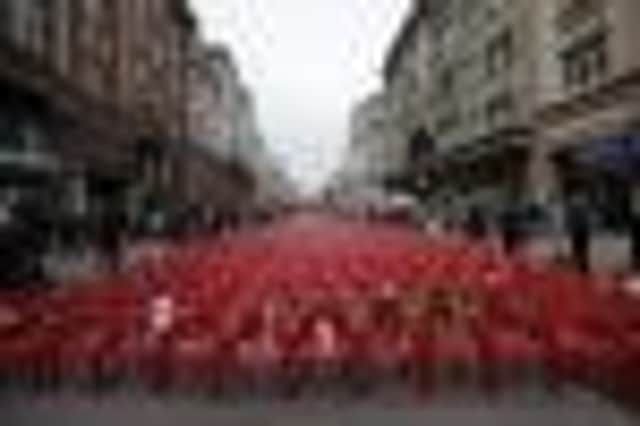In pictures: Sarajevo marks siege of city 20 years on with Red Line


Stretching through the streets, each of the 11,541 red plastic chairs commemorated somebody killed during the four year siege of the Bosnian capital that lasted from 1992-95.
Exactly twenty years ago on Friday, the last hopes of thousands of Bosnians who took to the streets to demand peace were shattered as Bosnian Serb snipers fired on the protest.
Advertisement
Hide AdAdvertisement
Hide AdYesterday, the red chairs stretched in silence all the way up Marshal Tito avenue, right through the centre of Sarajevo.
In some of the seats residents placed teddy-bears or cuddly toys belonging to some of the 643 children who were killed during the conflcit. On others there were yellow or red roses lying propped up: a 750-strong orchestra played to the empty rows of chairs, as thousands of Sarajevo residents and visitors walked past and looked on, some in tears.
”This city needs to stop for a moment and pay tribute to its killed citizens,” said Haris Pasovic, organiser of the Red Line.
Opposite a statue built to the children of Sarajevo killed during the war, two women rubbed away tears under their sunglasses as they looked at a large Mickey Mouse toy sitting in one chair.
“I mostly recall the near-continuous bombing, the snipers, the dead,” 64-year-old Fuad Novalija, a craftsman in Sarajevo’s old town.
“The shells fell when we least expected them. People were killed as they queued for water or bread.”
Bosnian Serb forces laid siege to Sarajevo from the surrounding mountains and hills that encircle the capital like an amphitheatre, sometimes firing more than 300 artillery shells a day.
“We were moving targets with only one priniciple left – that we would stay in the city,” Bosnian artist Suada Kapic recalled.
Advertisement
Hide AdAdvertisement
Hide AdThe country’s war left 100,000 people dead, more than a million displaced from their homes, the country divided in two. The only case of genocide committed on European soil since the Holocaust took place outside Srebrenica in eastern Bosnia in July 1995, when Bosnian Serb forces slaughtered an estimated 8,100 Bosnian Muslim men and boys.
Twenty years later, the country and the city are at peace: the 1995 Dayton Peace Accords brought an end to the fighting, and divided the country into two separate entities – the Serb-dominated Republika Srpska and the Muslim-Croat Federation.
The main perpetrators of the violence in have been bought to justice. Former Bosnian Serb president Radovan Karadzic is on trial in The Hague, after sixteen years on the run, as is Ratko Mladic, who commanded Serb forces around Srebrenica.
Of the 8,100 victims of that massacre, the remains of more than 6,700 of them have been identified using DNA by the International Commission on Missing Person. Chief operating officer Adam Boys, from Argyll, said this was a “scientific achievement unprecedented worldwide.”
But as those advances are made the politics of division have proven a bureaucratic, and costly, nightmare. Bosnia has a Serb, Croat and Muslim president at state level. Republika Srpska and the Federation each have a president and vice-president too. Then, there are 13 prime ministers and 130 ministers, supported by a bloated and grossly inefficient public sector, the entire administration costing Bosnia more than 50 per cent of its annual GDP.
“I think the majority of the people in this country realise that all of us came out of this war as losers, but I fear the majority has also failed to learn the lessons,” said 46-year-old Serbian Radoslav Zivkovic, from Pale.
“The political elites are the only winners of the war,” said Kurt Bassuener, senior policy analyst with the Democratisation Policy Council, a leading Sarajevo based think-tank that keeps tabs on both Bosnia’s politicians and their international overseers whose job is to implement the Dayton Accords.
But he claims the international community’s refusal to force Bosnian politicians to fully observe the Dayton agreement for the last six years has left local leaders operating in what he calls as “rules-free environment.”
Advertisement
Hide AdAdvertisement
Hide AdThe country has signed an SAA, or Stablisation and Association Agreement with the European Union, but while the rest of the south-eastern European is moving towards Brussels – Croatia hopes to join the European Union in July next year – Bosnia is getting there on its political and economic hands and knees.